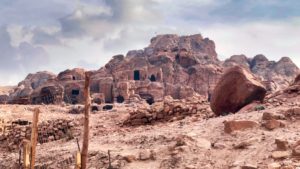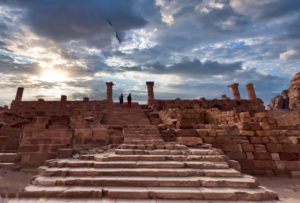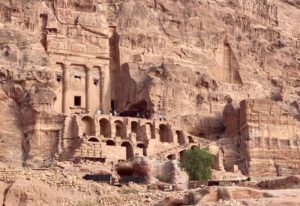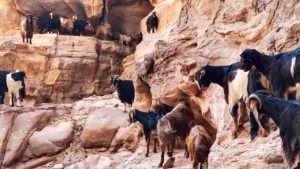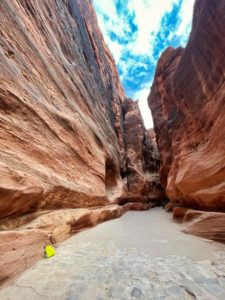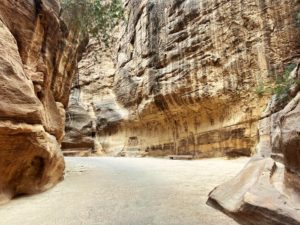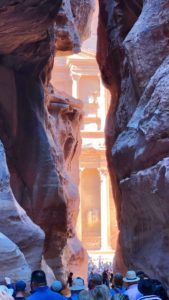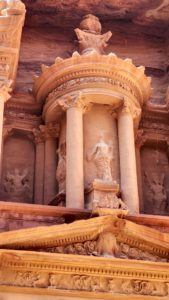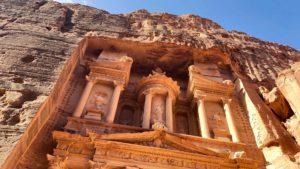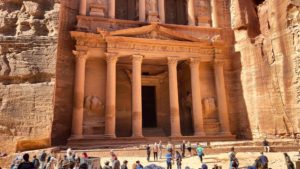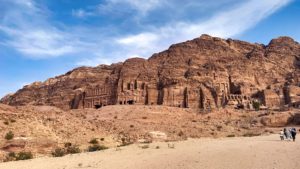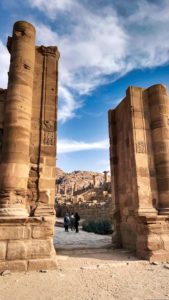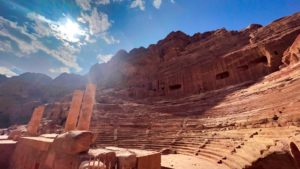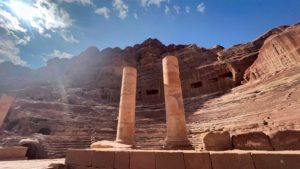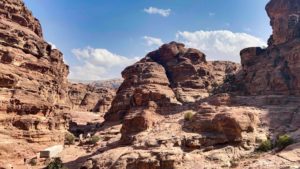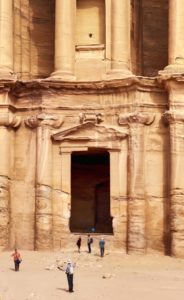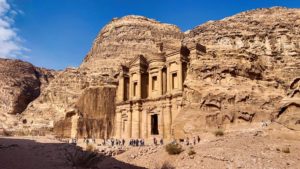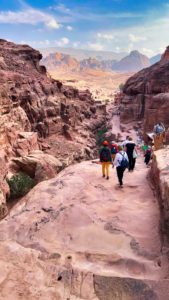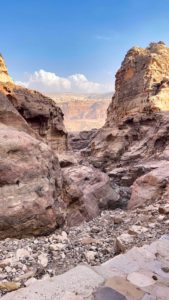The city of Petra in Jordan has all the structural integrity of a child's sandcastle. Frankly, if it ever rained more than the region's monthly average—00.15 inches—Petra would wash away without a trace. Luckily for Jordan's tourism board, rain only falls in the mountains, which are presumably made of something less dissolvable. Petra's ever‑present risk of erosion is just one of the many reasons you should see the place while you still can.
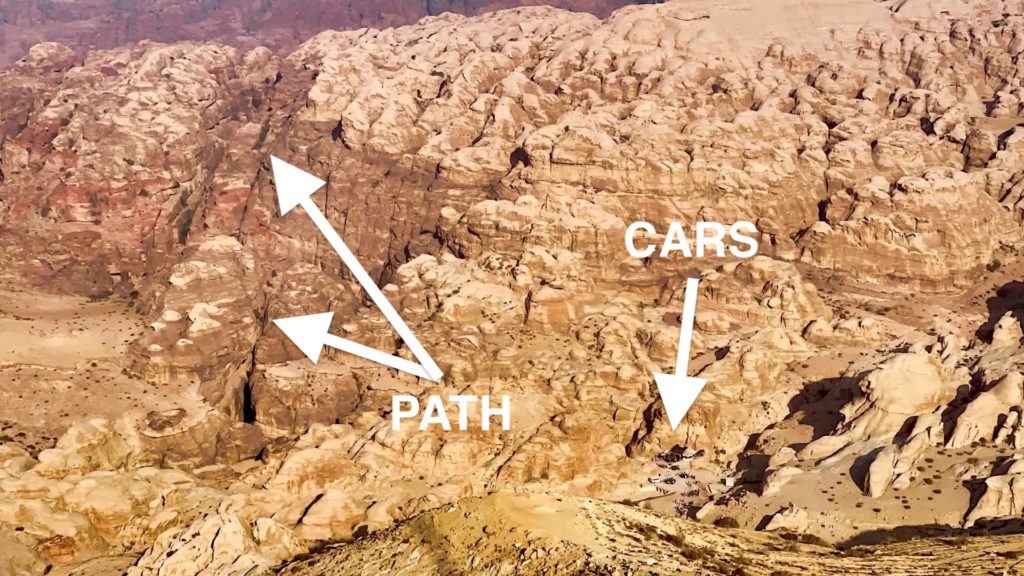
A brief history of the Jordanian city of Petra.
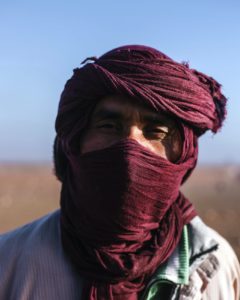
Despite its desertiness, Southern Jordan has been inhabited by humans for a long time, from as early as 7000 BCE. Those early occupants were primarily a group of nomadic Arabs known as The Nabataeans (shockingly, not the name of a folk band from the 1960s).
Over the centuries, the nomadic Nabataeans established Petra not only as their capital city, but also as a major hub along the incense trade routes. Incense was a highly coveted substance back then, as it made sweaty people smell less gross and nasty. The incense industry eventually fell into decline when it was supplanted by Axe® Body-Wash and indoor plumbing.
First you get the water, then you get the power, then you get the women.*

Much like Wadi Rum, this arid, sun-bleached region of southern Jordan gets only negligible rainfall each year, but it's regularly ravaged by flash floods, followed by prolonged periods of drought. So the Nabataeans learned to be Masters of Water Management (it was a doctorate degree at Jordan University, class of 5003 BCE).

Yet, recent archaeological evidence shows that the Nabataeans tamed those flash floods by building a complex network of dams, cisterns, and conduits. They redirected the floodwaters to huge rock-walled holes in the ground which could store hundreds of gallons (see photo at left). They could then release those reserves back to the city, as needed, through a system of water conduits (see conduit carved into lower part of wall in photo at right).
Having dependable water resources made Petra an artificial oasis in the Jordanian desert, leading to the city's popularity and prosperity. Unsurprisingly, their citizens' complete mastery over moisture made Petra home to Jordan's top-grossing Jet Ski® dealership, too.
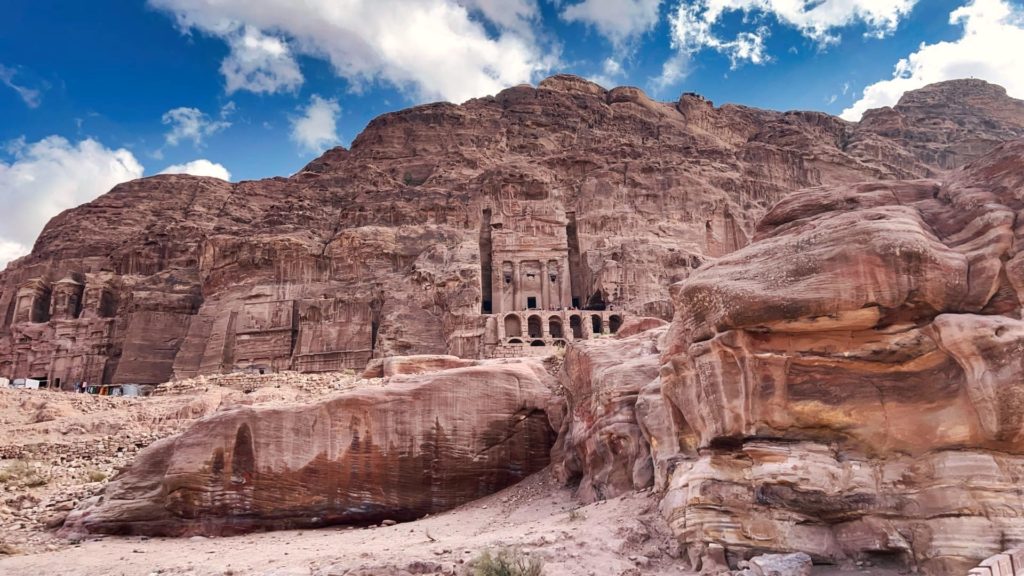
Petra was a very prosperous city (well, for a while anyway).
Situated between the Red and Dead Seas, Petra was located at an important crossroads between Saudi Arabia, Egypt, and Syria. Trading among these neighbors made the Nabataeans very rich. The region flourished during the 1st Century CE, with its population peaking at an estimated 20,000, some of whom were not prostitutes.
The cliff walls of Petra soon reflected the fruits of all that disposable income. Elaborately carved crypts dotted the landscape, as testaments to some of the city's very wealthy, but also very dead, citizens. Everything was going swimmingly for the Nabataeans until the Romans got wind of the place. Soon enough, their armies rolled into town and quickly “annexed” the area into submission. The Romans' dominance in Petra, however, didn't last long.
Petra's position of prominence petered out.
As faster sea routes emerged, Petra's importance and wealth slowly waned. Soon, the city was nothing more than a bathroom-break stopover, and its carved crypts, mere road-side attractions. What's worse, an earthquake in 363 CE destroyed many of the city's most impressive Roman structures. And that cataclysmic event sunk the final nail in Petra's prosperity coffin. By the 7th Century, people had all but abandoned the place.
With no human interference, goats and donkeys soon overran the city. They set up their own anarcho-syndicalist commune and lived in peace and harmony together for many years. Over time, however, the social-climbing goats introduced a caste system that relegated the donkeys to second-class status.
Donkey oppression inexorably led to a “Red Wedding”-style uprising, painting the town red with goat's blood, dooming their autonomous collective to anarchy and dissolution. Without social cohesion, the goats and donkeys scattered into the desert. Subsequent generations eventually just forgot that their hoofed forefathers could once talk.
Petra was Jordan's private playground for over a millennium.
For over 12 centuries, no Westerners even knew of Petra's existence. That is, until 1812, when a Swiss traveler (and Arabian cosplayer) named Johann L. Burckhardt convinced a local Jordanian that he was simply “a very light-skinned Arab,” and tricked the poor sap into showing him the city.
Immediately, he snitched to the media about Petra, spreading the word and causing Westerners to continually flock there for the next 210 years. Back in the tourism industry spotlight, Petra National Park is now one of the most frequented attractions in Jordan. A fact that I'm sure the locals just looooove.
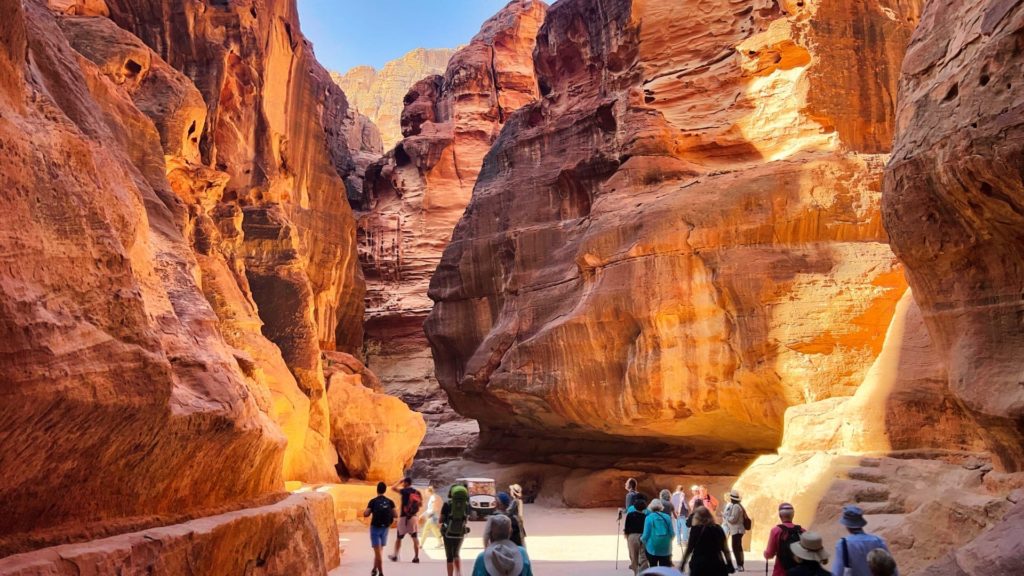
“Hiking the shaft” only sounds like a sex act (but isn't).
In ancient times, merchants and traders would approach Petra from the south, through Saudi Arabia. But today, most tourists enter this famous site from the east, through Wadi Musa, meaning “Valley of Moses,” or more accurately, “Valley of Tourist Hotels and Overpriced Cocktails.”
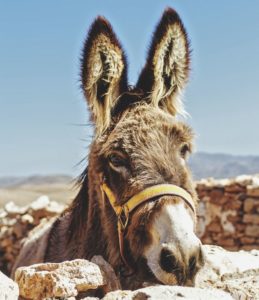
We stayed at the very nice, and conveniently located, Movenpick Petra in Wadi Musa. After a nice breakfast buffet—a long-held tradition of the Nabataean people, apparently—we headed towards Petra on foot. Had we been elderly, handicapped, or just incredibly lazy, we could've paid for a horse, donkey, or golf-cart ride. But since we needed to burn off that breakfast buffet, we opted to walk.
We strolled for what felt like three to five miles along a flat, stone and concrete path originally laid down by the Sacred Order of the Stonecutters, an Ancient Roman workers' union. The path—only 10‑feet wide, in parts—is constrained on both sides by imposing, one hundred foot high cliff walls. But what I found more impressive was the absence of advertising and billboards along the way.
The long, narrow gorge is a unique geological feature formed by a natural rift in the surrounding mountains. It's nicknamed “The Siq,” meaning, The Shaft. Yet, Nabataeans probably had a different name for this easily defendable entrance to their Capital city—something more along the lines of “Slaughter Street,” “Homicide Highway” or even “Annihilation Alley.”
Approaching the city of Petra is nothing short of epic.
Four miles in, the path finally ends. Up ahead, the cliff walls slowly part to reveal Petra's first, and most well-known monument, “the Treasury” (aka, Al Khazneh). At 130-feet tall, the Treasury requires wide-angle eyes to take it all in, and a helmet to contain your blown mind.
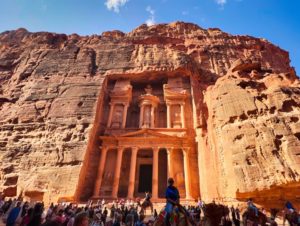
The Treasury's façade is an impressive bit of Hellenistic-style stone carving. Using nothing more than hammers, chisels, and some water, Nabatean artisans were able to whittle elaborate designs out of the area's soft, sandstone cliffs.
The interior of the Treasury required less skill, but far more effort. Some poor suckers had to dig out ~70,000 cubic feet of sandstone to create a main chamber and three antechambers. All just to store a bunch of dead, ungrateful corpses. I certainly hope the workers got paid in Pharaoh's treasure or something. #foreshadowing
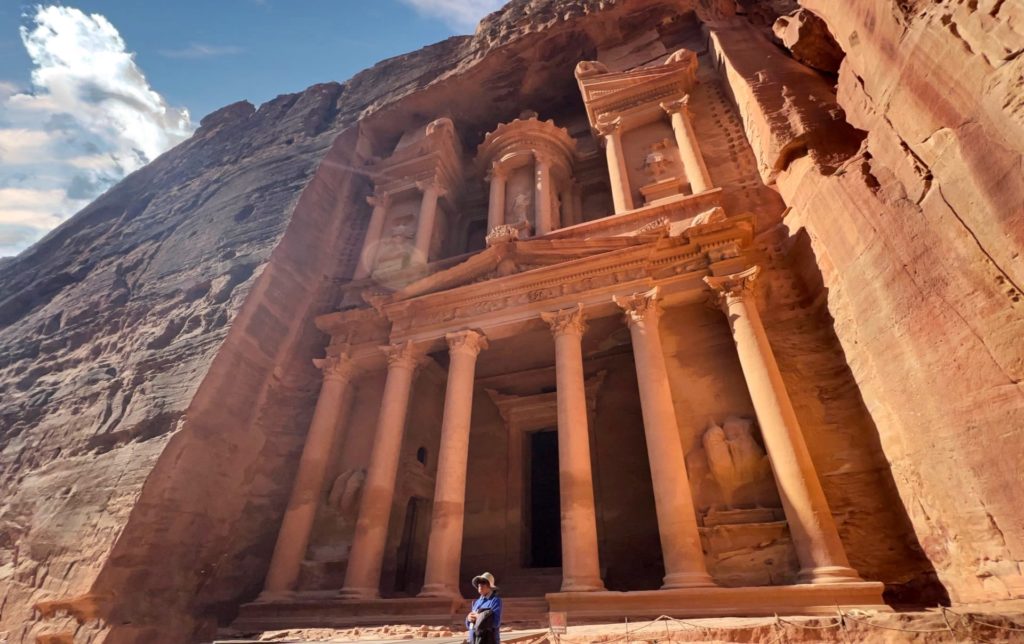
Was The Treasury carved using magic?
To carve the upper reaches of the cliffs, the Nabateans dug holes and inserted wooden beams to act as a scaffolding. Holes in the urn at the top of the Treasury, however, were put there by Bedouin rifles (see photo at left). The Bedouins believed that the solid, sandstone urn at the top somehow contained treasure. And, where'd they get that crazy idea, you might ask? Well, don't.
Legend has it that Egypt's Pharaoh—despite losing tons of troops in the “Great Red Sea Parting Debacle”—continued chasing Moses and the Israelites (also not a band name). In order to speed up what remained of his drenched army, the Pharaoh needed to shed some weight. Specifically, the super-heavy gold his men were carrying for no good reason.
According to this same legend, the Pharaoh used magic to create a place to store his “traveling money.” A place called, Khazneh el-Far'oun (or, “Treasury of the Pharaoh”). Strangely, the legend doesn't explain why the Pharaoh didn't use this same magic to capture Moses immediately and avoid a costly, protracted pursuit.
Like the Treasury itself, the truth is still up in the air.
Another story, as I heard it, told that the Treasury was simply misnamed by an arrogant British jackhole who didn't give a shit about other cultures. (Editor's Note: Using the descriptor, “British,” in the previous sentence is redundant).
The Brit thought Al Khazneh looked like a treasury, so he just named it that because, who cares? Worse, no other Westerner ever corrected his error. So now everyone thinks that the mausoleum of King Aretas IV (c. 1 CE) was the office of Petra's tax collector.
Petra is called the “Rose City” because people have eyes.
Around the corner from the Treasury, you begin to see the main center of Jordan's “Rose City.” The sprawling iron-rich hills around Petra, unsurprisingly, inspired one of the world's most obvious nicknames.
Petra's city center, where twenty thousand people went about their daily lives, offered all the amenities of ancient urbanism: walkability, stone footpaths, running water, and protection from Honey Badger attacks. It was a big step up from the nothingness of living anywhere else.
The hills surrounding Petra are all either pock-marked by natural caves, or pock-marked by natural caves carved into burial crypts. Yet many of these mausoleums were, inexplicably, left unfinished. I imagine it was because their intended inhabitants unexpectedly rose from the dead and began feasting on the living. As I understand it, that happened a lot before the invention of antibiotics.

Petra's amphitheater was the only show in town.
If you continue walking through the city center, and you'll come upon a massive, rose-colored Roman Colosseum-looking thing cut into the hillside. It's still in shockingly good condition, considering that it was heavily damaged by that earthquake in 363 CE. When fully packed, this large arena could reportedly hold up to 8,500 folks, many of whom were not prostitutes.
Now, you might think the amphitheater got its reddish color the same way the surrounding hills did. You know, from iron-rich minerals in the sand slowly breaking down and oxidizing into hematite crystals, which absorb all colors except red. Sure, but, that's not the whole explanation.
This venue likely got much of its color from the unending deluge of blood and gore gushing forth from gladiators' jugular veins, aortas, and bowels. After all, you can't entertain a restless citizenry for two millennia without breaking a few moral laws on a weekly basis (and twice on Sunday). Every inch of this sick-soaked stage is a revolting reminder that professional sports, rock concerts, and even monster-truck shows are somewhat recent inventions.
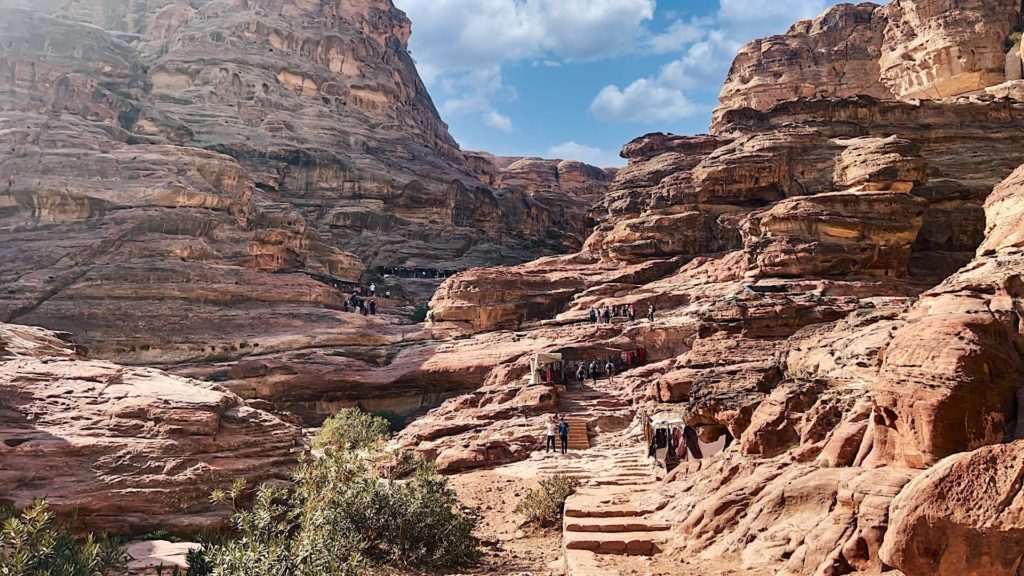
Getting up to The Monastery ain't easy on the knees.
Around noon, we strolled over to, and had lunch inside, The Basin Restaurant, a decent touristy place at the base of a nearby mountain that serves alcohol. While digesting our midday meal, we steeled ourselves for the grueling hike up to the monument known as Ad Deir (aka, “the Monastery”).

Located high in the red hills surrounding Petra, The Monastery is one of Petra's two most iconic monuments. It's the second most popular landmark because you have to climb over 850 uneven, knee-shattering steps to get there, and that hurts its popularity rating a bit.
If you go, you'll climb the equivalent of nearly 50 flights of stairs over the course of a grueling forty-five-minute hike. Sure, you could ride to the top on the back of a donkey. But, judging from their desperately pleading eyes, the donkeys don't seem too into the idea.
Donkey honks are really loud in canyons. I mean, super-freakin' loud.
What you see at the top will blow your mind.

After slogging your way towards the top, up a path that can only be described as masochistic, you're treated to an unbelievable sight—a f#c&ing coffee shop! Yeah, fancy ladies in sundresses, sunglasses, and sandals were already up there! And, unlike us, they weren't soaked in their own sweat, and maybe some bile.
They were casually eating scones and sipping lattes as if they'd gotten there by helicopter, an explanation we could not rule out. There has to be a secret back-road up to this place somewhere, but we never saw anyone lugging 50-pound sacks of coffee beans up that damned hell-path. Though, to be honest, our vision during most of the hike was pretty blurred. Still, I was thrilled to get a Coke Zero® up there, so it was worth the hike. Oh, and the view up there wasn't bad, either.
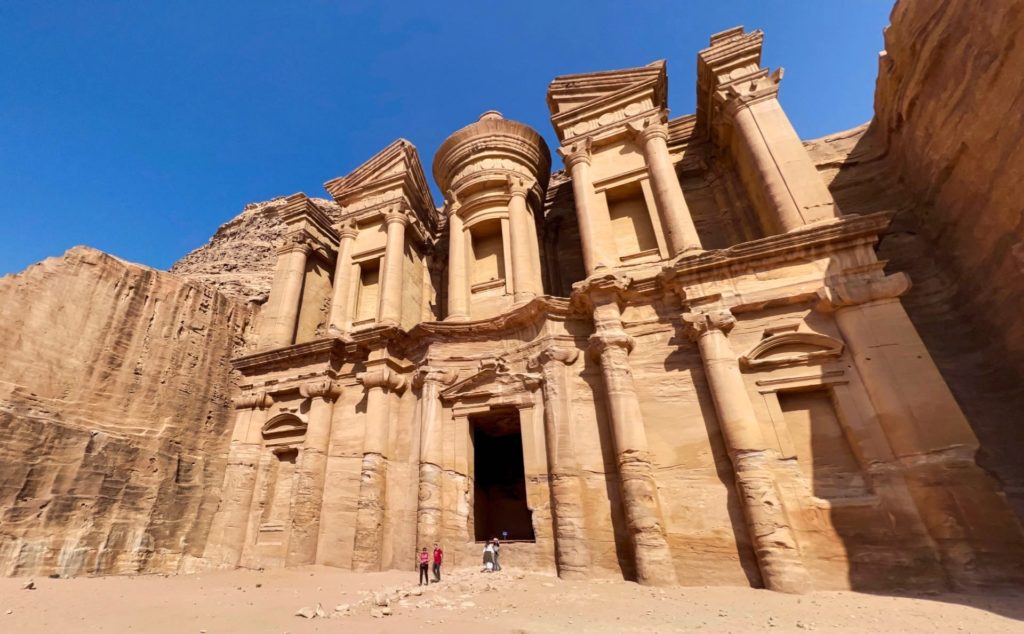
The Monastery (“Ad Deir”) is worth two weeks of Tylenol®.
Much like Al Khazneh, Ad Deir is mostly façade, too. But, it is a massive 154′ tall and 157′ wide façade—and that's a lot of face. That's even more face than Jennifer Garner (she's got a five-head…bada-bing).
Yet, rather than being a simple one-crypt pony like the Treasury, Ad Deir was thought to serve religious purposes, as well. So maybe calling this place “the Monastery” wasn't as far off as the whole Treasury-naming clusterf#ck.
Archeologists now think there might have been more structure extending out in front of the Monastery—a section that was later torn down, they believe. Most likely, it was leveled to accommodate the larger crowds that were attracted by the Monastery's human sacrifice ceremonies and after-hour MDMA raves.
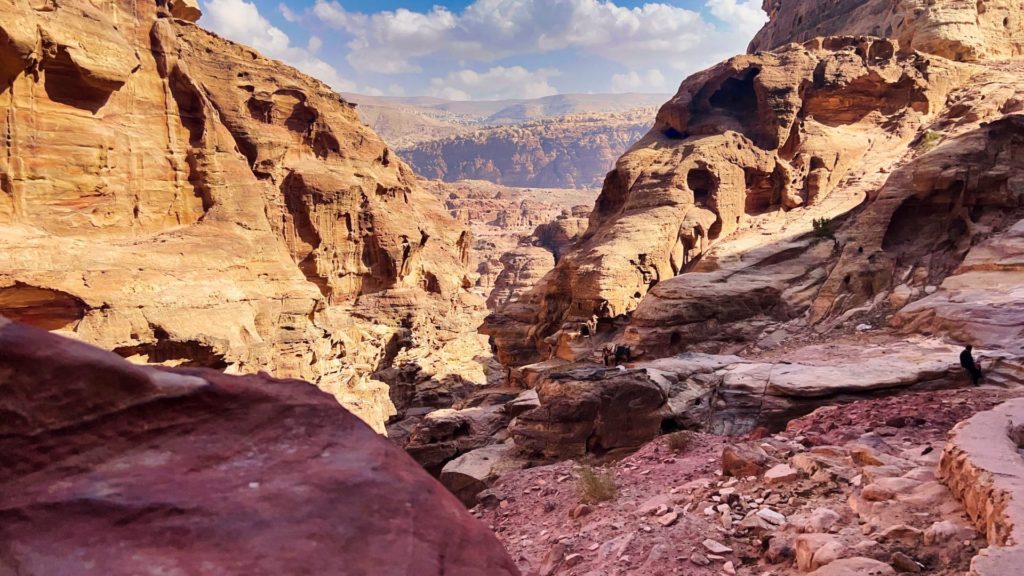
Hiking down from the Monastery involved a fair amount of profanity.
We took in all the majesty that is Ad Deir's mixture of Hellenistic and Mesopotamian architectural styles until we remembered that we had to hike back down. That seemed like an unpleasant prospect, so we ordered another drink instead and sacked out on one of the coffee shop couches for a while longer.
With the sun about to set, we finally dragged our lazy asses down the mountain, hoping to avoid stumbling to our untimely deaths in the dark. Upon reaching the city center, we realized that our hotel was still another four-mile trek back through The Siq. This knowledge led to a fair bit of weeping.
By the time we returned to the Movenpick Petra, we were sunburned, hallucinating, and speaking in tongues. At least, that's what the medical report said—we were pretty out of it by then. But after a few drinks, a handful of Advil®, and a good night's sleep, we were able to continue living.
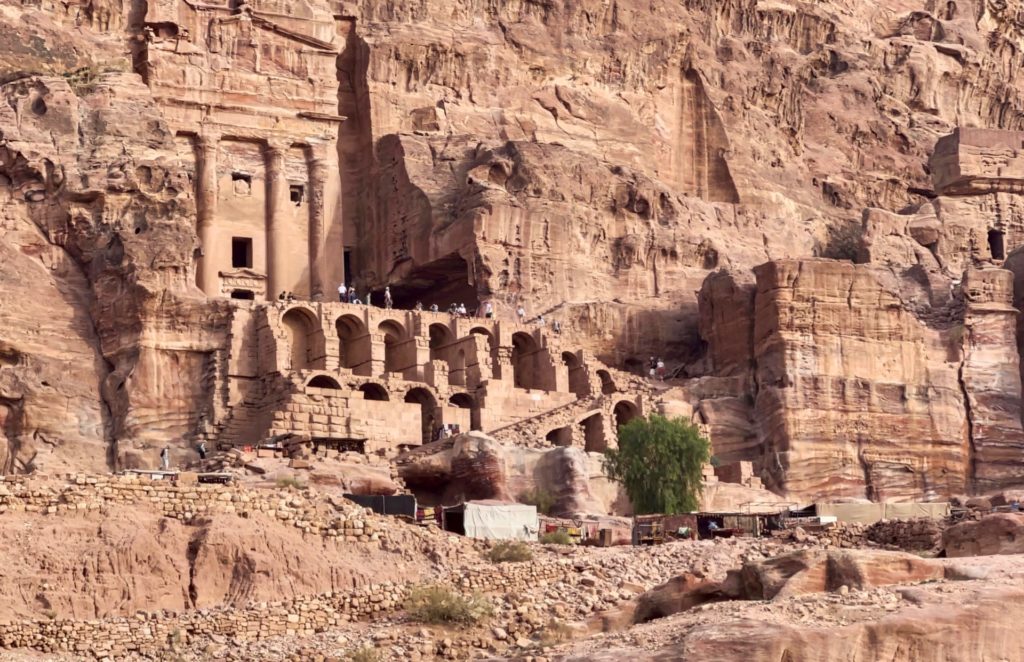
Jordan's Rose City is, in a word, mind-boggling.
Visiting Petra is less like visiting a different country, and more like visiting a different planet. It's the weird kind of planet you'd see on the original 1960s version of Star Trek®. A planet where the alien race has green skin and antennae. But the female of the species is somehow still humanoid and hot. The whole time we were there, I half expected a Gorn to jump out and attack us.
I'd wanted to visit Petra National Park ever since I first saw photos of the place. And I can honestly say that it certainly lived up to the hype. In addition to all the spectacular landscapes, ancient ruins, and stunning architecture, Petra was full of surprises. Thankfully, none of them was a Gorn attack. But, to be safe, I wouldn't rule it out.
*It's a Simpson's reference.

